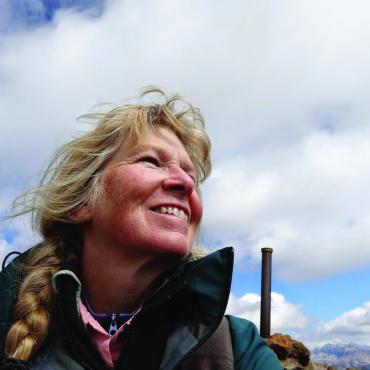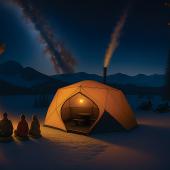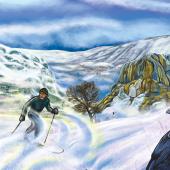Northern Exposure
Hiking Yellowstone's boundary trails.
There’s nothing like running your hands over the bark of a scarred tree to get a sense of those who came before, whether it’s the mark of a grizzly, an elk working to shed the velvet from its antlers in late summer, or the aspen carvings of a lonely Basque sheepherder. Hiking through the high country in and around Yellowstone, my own interest is piqued when I encounter the remnants of the Park’s early-day surveyors.
Yellowstone National Park was created March 1, 1872, and the Park’s north boundary was set as “the latitude of the junction of the Yellowstone and Gardiner rivers.” However, no funds were allocated to survey the new Park and boundary surveys were not completed until 1908.
Those original boundaries were marked at mile and half-mile markers with a few basalt markers, but mostly with squared native timbers, most of which had to be replaced in the 1980s. However, later boundary adjustments were posted with brass caps in the 1930s and can still be located today.
Almost as soon as the Park was established, people began suggesting that boundaries be adjusted. These suggestions for boundary changes have an uncanny resemblance to today’s calls for public-lands transfers, with arguments on all sides about who best can manage the lands. Ultimately, President Hoover signed the Yellowstone Park Boundary Adjustment Act on March 1, 1929, the first bill changing the Park’s boundaries.
A unique hike to a portion of this revised boundary takes you up to Wolverine Peak, accessed from Daisy Pass south of Cooke City. Wolverine Peak marks the very northeast corner of Yellowstone Park, and overlooks the New World Mining District, home to one of the best-known land-use battles of the 1990s.
The dispute began in the 1989 when Crown Butte Mines proposed a substantial gold mine just northeast of Cooke City. As with today’s proposals near Emigrant, this was seen as a threat to the waters of Yellowstone Park, and was ultimately resolved in 1996 with a deal that included abandoning the mining proposal and a $22.5 million fund for abandoned mine cleanup in the area below Wolverine Peak.
As you drive the primitive roads to start the hike to Wolverine Peak, you pass through the completed work and note what a substantial effort went into the restoration. Hiking higher up the flank of Wolverine Peak, you begin to note the surveyor’s brass caps, and almost envy his job at the top of the world.
To the east you pick out Crown Butte; to the southeast, Pilot and Index peaks; and to the north, the rugged heart of the Beartooths, including Tempest and Granite peaks. In addition, you can pick out the familiar profile of Cutoff Mountain above Slough Creek Guard Station to the west, once also known as Wolverine Peak.
Another trail rich with the boundary-trail legacy is Sky Rim on the northwest boundary of the Park. The trail isn’t located on the original Park boundary as established in 1872, but instead reflects the line established by the Boundary Adjustment Act of 1929.
Use Sky Rim for a multi-day hike to the alpine country of High and Shelf lakes, along the divide overlooking Tom Miner Basin, or simply as a day-hike linking Tepee and Dailey Creek trails. Note survey markers as you traverse the petrified forest, even locating one on an eight-foot petrified stump. The portion of the trail extending northwest from Big Horn Peak is particularly precipitous, with stunning sheer rock cliffs, before descending down to the open meadows and sage hills of Dailey Creek.
Interestingly, after having been added to the Park in 1929, this area was considered for possible exclusion in 1961, due to the intermingled “checkerboard” of private lands (which no longer exist), and to allow elk hunting. The controversial proposal included at least one alternative to transfer land to the state to better manage the elk.
In the end, it was concluded that the prime lands at the heart of the Sky Rim country were still considered worthy of Park designation, and “contains such scenic and scientific values that if it were now detached from Yellowstone it would be considered for separate park or monument status.”
These days, the idea of boundaries has evolved. Land-management agencies were fierce in their defense of different missions and making sure there was no “trespass” occurring. Since then, we’ve started talking about the Greater Yellowstone Ecosystem, recognizing that most of the resources we cherish don’t follow arbitrary boundaries, whether federal or private. Posting boundaries is no longer seen as the solution to challenging environmental issues. But it sure is cool to stumble across one of these historical markers of a time gone by.
As you hike the peaks and ridges that form the boundaries of Yellowstone Park, respect these and other historical artifacts. Be grateful to those who went before and left them untouched.













